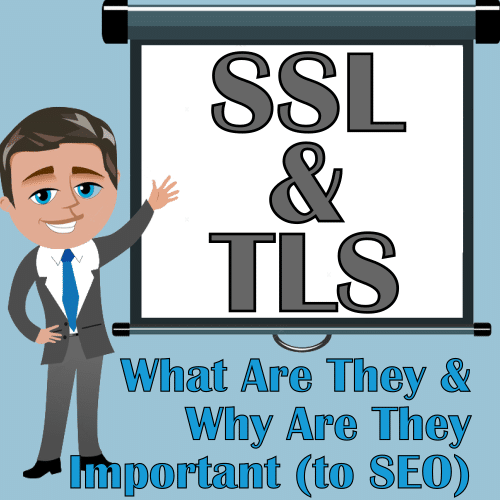 Secure Sockets Layer (SSL) technology and it’s newer branch Transport Layer Security (TLS) are languages for communicating authenticated, secured and encrypted URLs across networked computers. The most recent release of the protocol is TLS 1.3, defined in RFC 8446 and dating to August of 2018. SSL/TLS security integrates into on-site optimization by tying the profiles of properties such as websites and businesses to cryptographic key combinations through digital documents labeled X.509 certificates. Every key combo is built by a private key and a public key. The private key is held protected, and the public key is available for public distribution. The unique numerical affiliations and alliances between the private and public keys are what make it possible to encrypt and decrypt controllable data over computer networks. Designed to be the foundation of secure online web browsing and electronic commerce, Secure Sockets Layer (SSL) and Transport Layer Security (TLS) frameworks pave the way for trusted computer usage and on-site optimization.
Secure Sockets Layer (SSL) technology and it’s newer branch Transport Layer Security (TLS) are languages for communicating authenticated, secured and encrypted URLs across networked computers. The most recent release of the protocol is TLS 1.3, defined in RFC 8446 and dating to August of 2018. SSL/TLS security integrates into on-site optimization by tying the profiles of properties such as websites and businesses to cryptographic key combinations through digital documents labeled X.509 certificates. Every key combo is built by a private key and a public key. The private key is held protected, and the public key is available for public distribution. The unique numerical affiliations and alliances between the private and public keys are what make it possible to encrypt and decrypt controllable data over computer networks. Designed to be the foundation of secure online web browsing and electronic commerce, Secure Sockets Layer (SSL) and Transport Layer Security (TLS) frameworks pave the way for trusted computer usage and on-site optimization.
The most traditional use of Secure Sockets Layer (SSL) and Transport Layer Security (TLS) is guarded web browsing through the HTTPS code platform. A correctly designed public HTTPS website features an SSL/TLS certificate that is verified by a trusted certificate authority (CA). Users visiting a properly programmed HTTPS website can be assured of authenticity, integrity, encryption within their internet based experience via SSL/TLS certifications. The languages of SSL/TLS and HTTPS allow website visitors to securely transmit confidential information such as financial transactions, social security numbers, and login credentials over the internet. SSL/TLS certificates change based on reference preferences, with extended validation (EV) offering the highest level of trust, domain validated (DV) being the most common and organization validated (OV) being designated for enterprise and corporate level implementations. The standard procedures for requesting a publicly trusted SSL/TLS website certificate is easy with the help of a knowledgeable on-site optimization website design team and the below partner types.
Option #1: Host Provided
Most high quality hosting services offer Secure Sockets Layer (SSL) and Transport Layer Security (TLS) with their website packages. Before selecting a website host it is always best to check with your website design company and the hosting company to learn more about what is available in terms of SSL/TLS on-site optimization.
Option #2: Free SSL Using ZeroSSL
If you do not go with your hosting provider for your Secure Sockets Layer (SSL) and Transport Layer Security (TLS) security then you will want to look into free options like ZeroSSL. With a free product like ZerSSL you can implement a software package which generates SSL certificates on your own computer server network. You can also command the client application to issue and renew SSL certificates for your sites automatically and even design your own client application. TheZeroSSL client runs on multiple platforms like Linux, FreeBSD, NetBSD, Mac OS X, Windows to cover all your on-site optimization SSL/TLS needs.
You can learn more about ZeroSSL, along with how to implement on your own website here
Secure Sockets Layer (SSL) technology and Transport Layer Security (TLS) is important because it lays a foundation of trust and protection for websites and the visitors that use them. Offering website owners such key benefits as automatic registration, automatic CSR generation, domain verification handling, conditional renew, integration with external modules, certificate revocation and so much more SSL/TLS provides website owners and internet users the peace of mind of online safety and security. To get the very best in on-site optimization one must always make sure they protect themselves and others through proper Secure Sockets Layer (SSL) technology and Transport Layer Security (TLS) protocols. Since modern web browsers like Google Chrome, Firefox and Safari are also now warning visitors about insecure websites that do not have an SSL/TLS certificate it is now more important than ever to make this type of technology a part of your on-site optimization and search engine optimization (SEO) strategies.
Let’s Work Together
TELL US MORE ABOUT YOUR PROJECT
Let us help you get your website found. Or, if you simply have a few questions, then fill out the form below and we will get back to you.
